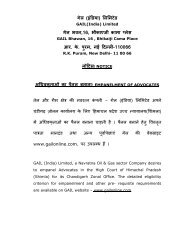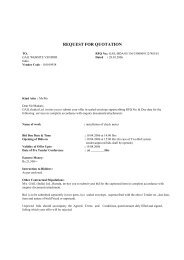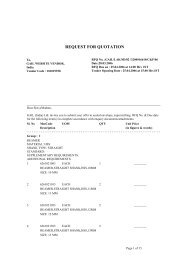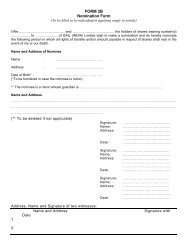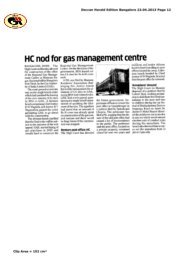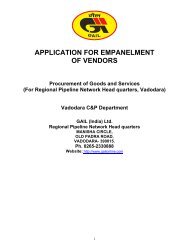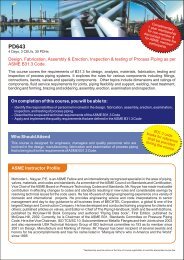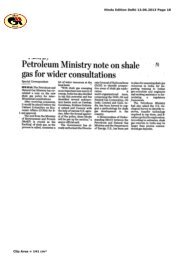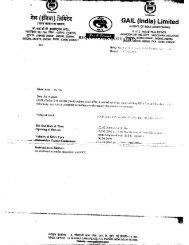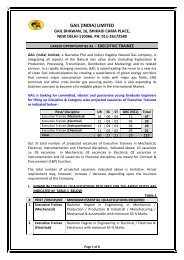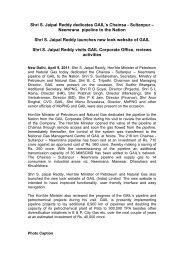GAIL (India) Limited
GAIL (India) Limited
GAIL (India) Limited
- No tags were found...
You also want an ePaper? Increase the reach of your titles
YUMPU automatically turns print PDFs into web optimized ePapers that Google loves.
92.3 PRE-CONSTRUCTION CHEMICAL TREATMENTThis is a process in which chemical treatment is applied to a building in the early stages of its constructionat the rate specified In IS 6313 part II of 2001 or the latest edition.Hand operated pressure pump shall be used for uniform spraying of the chemical. To have proper checkfor uniform spraying of chemical graduated containers shall be used. Proper check should be kept thatspecified quantity of chemical is used for the required areas during the operation.2.4 TIME OF APPLICATIONSoil treatment shall start when foundation trenches and pits are ready to take lean concrete in foundations.Laying of lean concrete shall start when chemical emulsion has been absorbed by the soil and the surfaceis quite dry. Treatment should not be carried out when it is raining or soil is wet with rain or sub soilwater. The foregoing applies also in the case of treatment to the filled earth surface within the plinthbefore laying the sub grade for the floor.2.5 DISTURBANCEThe treated soil barriers shall not be disturbed after they are formed. If by chance, treated soil barriers aredisturbed, immediate steps shall be taken to restore the continuity and completeness of the barrier system.2.6 TREATMENT OF COLUMN PITS AND WALL TRENCHESa) The bottom surface and the sides (up to a height of above 300 mm) of the excavation made forcolumn pits and trenches shall be treated with the chemical at the rate specified in IS 6313 part IIof 2001 or the latest edition.b) After the column foundation and the wall foundation come up, the back fill in immediate contactwith the foundation structure shall be treated at the rate specified in IS 6313 PART OF 2001 orthe latest edition of the vertical surface of the substructure for each side If water is used forramming the earth fill, the chemical treatment shall be carried out after the ramming operation isdone by prodding the earth at 150 mm centers close to the wall surface and spraying the chemicalwith the above dose. The earth is usually returned in layers and the treatment shall be carried outin similar stages. The chemical emulsion shall be directed towards the concrete to masonrysurface of the columns and walls so that the earth in contact with these surfaces is well treatedwith the chemical.c) In the case of R.C.C. framed structure with columns and plinth beams and R.C.C basement withconcrete, mix is rich and dense (being 1:2:4 or richer), it is unnecessary to start the treatmentfrom the bottom of excavation for columns and plinth beams. The treatment shall start at thedepth of 500 mm below ground level. , From this depth the back-fill around the columns, beamsand R.C.C. basement wall shall be treated at the rate as per IS 6313 Part II of 2001 or the latestedition. The other details of treatment shall be as laid down in the Clause (b) above.2.7 TREATEMENT OF TOP SURFACE OF PLINTH FILLINGThe top surface of the filled earth within plinth wall shall be treated with chemical emulsion at the rate asper IS 6313 Part II 2001 or the latest direction (surface area) before the sand/sub-grade is laid. Holes up to50 to 70 mm deep at 150 mm centers both ways shall be made with crow bars on the surface to facilitatesaturation of the soil with chemical emulsion.2.8 TREATEMENT OF JUNCTION OF WALL AND FLOORTo achieve continuity of the vertical chemical barrier on inner wall surface from the ground level, smallchannel 30 X 30 mm shall be made at all the junctions of wall and columns with the floor (before layingthe sub-grade) and rod holes made in the channel up to ground level 150 mm apart and the chemicalemulsion poured along the channel as per rate of application, mentioned in IS 6313 Part II (2001) or thelatest edition so as to soak the soil right up to bottom. The soil shall be tamped back into place after thisoperation.




